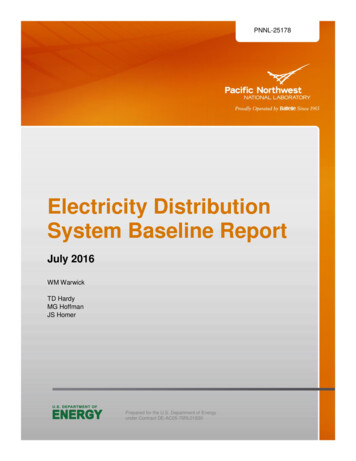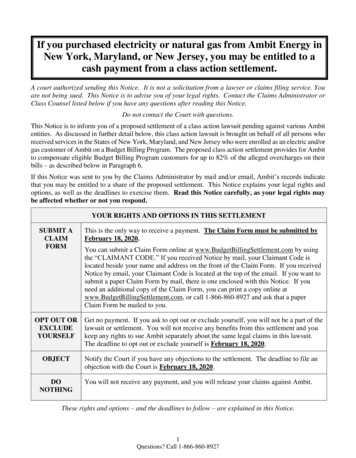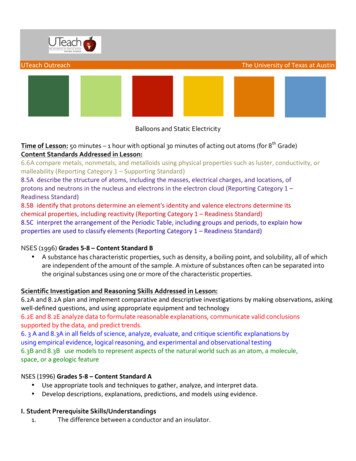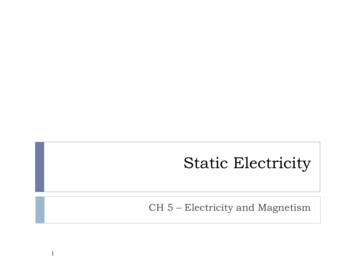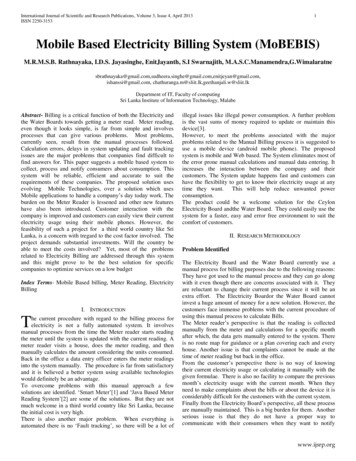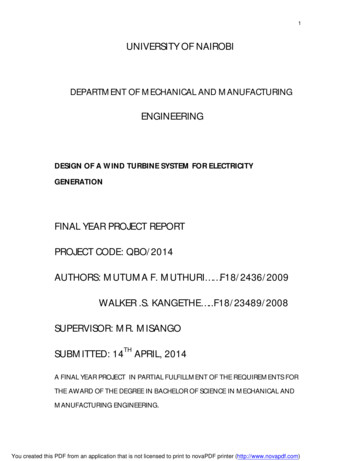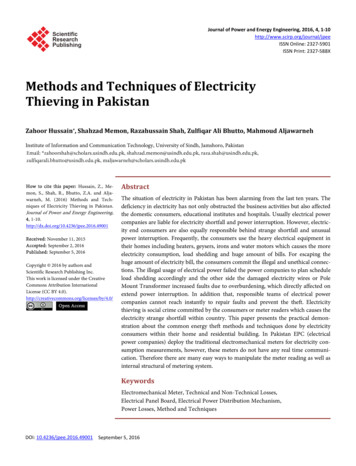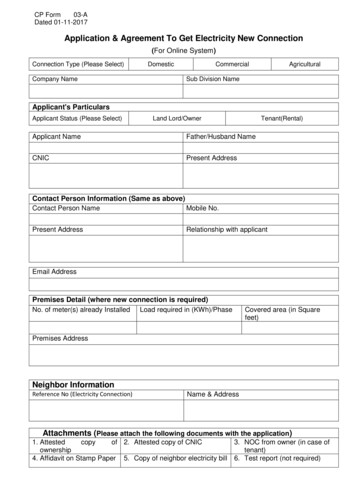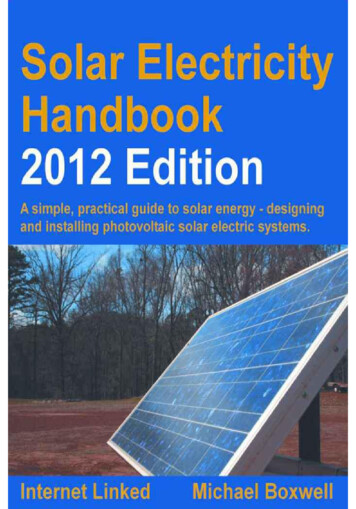
Transcription
Solar Electricity HandbookA simple, practical guide to solarenergy: how to design and installphotovoltaic solar electric systems2012 EditionMichael Boxwellwww.GreenstreamPublishing.com
Greenstream Publishing12 Poplar Grove, Ryton onDunsmore, Warwickshire, CV83QE. United KingdomCopyright Michael Boxwell2009–2012Published by GreenstreamPublishing 2012Smashwords Edition: ISBN 978-1907670-23-7Kindle Edition: ISBN 978-1907670-22-0First Edition – published April2009
Second Edition – publishedNovember 2009Third Edition – published March2010Fourth Edition – published January2011Fifth Edition – published October2011Sixth Edition – published February2012Editor: Sheila GlasbeyMichael Boxwell asserts the moralright to be identified as the authorof this work.A catalogue record for this book isavailable from the British Library.
Whilst we have tried to ensure theaccuracy of the contents in thisbook, the author or publisherscannot be held responsible for anyerrors or omissions found therein.All rights reserved. No part of thispublication may be reproduced,stored in a retrieval system, ortransmitted, in any form or by anymeans, electronic, mechanical,photocopying, recording orotherwise, without the priorpermission of the publishers.
Table of ContentsTable of ContentsIntroducing Solar EnergyWho this book is aimed atThe rapidly changing world ofsolar energySolar electricity and solar heatingThe source of solar powerThe principles of solar electricityUnderstanding the terminologySetting expectations for solarelectricityWhy choose a solar electricsystem?Cost-justifying solar
Solar power and wind powerFuel cellsGrid-tied solar electric systemsSolar electricity and theenvironmentEnvironmental efficiency:comparing supply and demandIn conclusionA Brief Introduction to ElectricityDon’t panicA brief introduction to electricityHow to measure electricityThe relationship between volts,amps, ohms, watts and watt-hoursVoltsPower
EnergyA word for non-electriciansIn conclusionThe Four Configurations for SolarPowerStand-alone/off-gridExamples of simple stand-alonesystemsGrid-tieAn example of a grid-tie systemGrid-tie with power backup (gridinteractive)An example of a grid interactivesystemGrid fallbackAn example of a grid fallback
systemGrid failoverHow grid-tie systems differ fromstand-aloneIn conclusionComponents of a Solar ElectricSystemSolar panelsBatteriesControllerInverterElectrical devicesConnecting everything togetherA stand-alone systemA grid-tie system using a singlecentral inverterA grid-tie system using multiple
micro-invertersIn conclusionThe Design ProcessShort-cutting the design workSolar energy and emotionsIn conclusionScoping the ProjectDesigning grid-tie or grid fallbacksystemsComparing supply with demandFleshing out the scopeProducing a power analysisA word of warningWhen you are ready to proceedCalculating inefficienciesAdding the inefficiencies to our
power analysisWhen do you need to use the solarsystem?Keeping it simpleImproving the scopeIn conclusionCalculating Solar EnergyWhat is solar energy?Why is this useful?Calculating solar irradianceCapturing more of the sun’senergyThe impact of tilting solarpanels on solar irradianceCalculating the optimum tilt forsolar panelsGetting the best from solar
panels at different times of theyearPositioning your solar panelsUsing solar irradiance to workout how much energy a solarpanel will generateUsing solar irradiance to giveyou an approximate guide for therequired power capacity of yoursolar arraySolar panels and shadeSolar array power pointefficienciesThe effects of temperature onsolar panelsTemperature impact on solarperformance in Austin, Texas
during the summer monthsWorking out an approximate costWhat if the figures do not addup?Working out dimensionsIn conclusionSurveying Your SiteWhat we want to achieveWhat you will needFirst impressionsDrawing a rough sketch of thesitePositioning the solar tting the solar array into
several smaller arraysIdentifying the path of the sunacross the skyShadingProfessional tools for obstacleanalysisCell phone applicationsUsing paper and pencilFuture proof your systemWhat if there are shadingobstructions?Positioning batteries, controllersand invertersCablingSite survey for the holiday homeIn conclusion
Understanding the ComponentsHow to use these chaptersCommon components for allsystemsSolar panelsAmorphous solar panelsPolycrystalline solar panelsMonocrystalline solar panelsWhich solar panel technology isbest?What to look for when choosinga solar panelBuying cheap solar panelsSecond-hand solar PV panelsFresnel lenses and mirrorsSolar panel mountingsSolar trackers
Solar array cablesFuses and isolation switchesGround fault protectionComponents for Grid-Tie systemsHigh voltage in-seriesLow voltage systemsMicro-inverter systemsGrid-tie solar panelsGrid-tie invertersInput voltagePower ratingPower trackingMultiple stringsDiagnostics and reportinginformationBuilt-in safety
Installation options andoperating environmentBuying from eBayComponents for Stand-AloneSystemsCalculate your optimum voltageVoltages and currentsWhat voltages can I run at?How to work out what voltageyou should be running atHow to calculate your currentCalculating cable thicknessesConverting wire sizes:Mixing and matching solar panelsBatteriesTypes of batteries
Battery configurationsBattery lifespanHoldoverCalculating how long a set ofbatteries will lastSecond-hand batteriesBuilding your battery bankBattery safetySolar controllerBalancing the batteriesAllow for expansionMaximum power point trackingGround fault protectionBackup powerUsing multiple controllersInvertersBattery bank voltage
Power ratingWaveformInstallation options andoperating environmentGround fault protectionCablesBattery cablesAppliance cablingPlugs and socketsAppliancesLightingRefrigerationMicrowave ovensTelevisions, DVDs, computergames consoles and musicMusic systemsDishwashers, washing machines
and tumble dryersAir conditioning systemsReputable brand namesSolar panel manufacturers andbrandsSolar controller and invertermanufacturers and brandsBattery manufacturers andbrandsShopping list for the holiday homeIn conclusionPlanning, regulations and approvalsNational and internationalstandards for solar componentsInstallation regulationsGetting your electricity supplierinvolved
Solar grants and selling yourpowerGeneral information aboutgrants, tax credits and feed-intariffsIn conclusionDetailed DesignSafety is designed inWhat is the worst that canhappen with a solar installation?Grounding your electricsDC ElectricsAC electricsHigh temperaturesThink safetySolar array design
Solar array design – stand-alonesystemsSolar array design – grid-tiesystems with micro-invertersSolar array design – grid-tiesystems with a single s for a grid fallbacksystemCircuit protectionEarthing (grounding)DC circuit protectionAC circuit protectionCable sizing and selection
Sizing your cablesProtecting cable runsDesigning your system to keepyour cables runs as short aspossibleSelecting solar cableController cableBattery interconnection cablesSome sample wiring diagramsThe holiday home wiringdiagramThe next stepSolar frame mountingPositioning batteriesPlanning the installationIn conclusion
InstallationHave you read the instructions?SafetyYour First Aid kitChemical clean-up kitConsidering the general publicWorking at heightHandlingWorking with batteriesGlovesElectrical safetyAssembling your toolkitPreparing your siteTesting your solar panelsInstalling the solar arrayCleaning the panelsAssembly and connections
Roof-mounting a solar arrayFinal wiringInstalling the batteriesPre-installationPositioning the talling the control equipmentInstalling a grid-tie systemCommissioning the systemProgramming your solarcontrollerTesting your systemCharging up your batteriesConnecting your devices
In conclusionTroubleshootingKeep safeCommon faultsExcessive power usageSolutionsInsufficient power generationSolutionsDamaged wiring/ poorconnectionsWeak batteryChanging batteriesInverter issuesMaintaining Your SystemAs requiredEvery month
Every three monthsEvery six monthsEvery yearAt the start of each winterInternet SupportTools available on the websiteOnline project analysisMonthly insolation figuresSolar angle calculatorSolar resourcesQuestions and answersAuthor online!Solar articlesA Final WordAppendix A – Crystalline SolarPanels and Shading
Types of obstructionDesigning shade-tolerant solarsystemsTrack the shadeIncreasing the number of solarpanelsPanel orientationChoice of solar panelUse micro-invertersDesign a parallel solar arrayDesign a multi-string solar arrayOther optionsIf all else fails.In conclusionAppendix B – Solar InsolationUnderstanding this information
Solar insolation values –AustraliaSolar insolation values –CanadaSolar insolation values – IrelandSolar insolation values – NewZealandSolar insolation values – UnitedKingdomSolar insolation values – UnitedStates of AmericaAppendix C – Typical PowerRequirementsHousehold and officeGarden and DIYCaravans, boats and recreational
vehiclesAppendix D – Living Off-GridA solar electric system inconjunction with grid electricityAppendix E – Other Solar ProjectsGrid fallback system/ gridfailover systemPortable solar power unitSolar boatSolar shed lightSolar electric bikesAppendix F – Building Your OwnSolar Panels (and Why YouShouldn’t)
Introducing SolarEnergyNinety-three million miles fromEarth, our sun is 333,000 times thesize of our planet. It has a diameterof 865,000 miles, a surfacetemperature of 5,600 C and a coretemperature of 15,000,000 C. It is ahuge mass of constant nuclearactivity.Directly or indirectly, our sunprovides all the power we need toexist and supports all life forms.The sun drives our climate and our
weather. Without it, our worldwould be a frozen wasteland of icecovered rock.Solar electricity is a wonderfulconcept. Taking power from the sunand using it to power electricalequipment is a terrific idea. Thereare no ongoing electricity bills, noreliance on a power socket: a freeand everlasting source of energythat does not harm the planet!Of course, the reality is a littledifferent from that. Yet generatingelectricity from sunlight alone is apowerful resource, withapplications and benefits throughout
the world.But how does it work? For what isit suitable? What are thelimitations? How much does itcost? How do you install it? Thisbook answers all these questionsand shows you how to use thepower of the sun to generateelectricity yourself.Along the way, I will also expose afew myths about some of the wilderclaims made about solar energy andI will show you where solar powermay only be part of the solution.Although undoubtedly there aresome significant environmental
benefits of solar electricity, I willalso be talking about where itsenvironmental credentials havebeen oversold.I will keep the descriptions asstraightforward as possible. Thereis some mathematics and scienceinvolved. This is essential to allowyou to plan a solar electricinstallation successfully. However,none of it is complicated and thereare plenty of short-cuts to keepthings simple.The book includes a number ofexample projects to show how youcan use solar electricity. Some of
these are very straightforward, suchas providing electrical light for ashed or garage, for example, orfitting a solar panel to the roof of acaravan or boat. Others are morecomplicated, such as installingphotovoltaic solar panels to ahouse.I also show some rather moreunusual examples, such as thepossibilities for solar electricmotorbikes and cars. These areexamples of what can be achievedusing solar power alone, along witha little ingenuity and determination.I have used one main example
throughout the book: providingsolar-generated electricity for aholiday home which does not haveaccess to an electricity supply fromthe grid. I have created this exampleto show the issues and pitfalls thatyou may encounter along the way,based on real life issues andpractical experience.A website accompanies this book.It has lots of useful information,along with lists of suppliers and asuite of online solar energycalculators that will simplify thecost analysis and design processes.The website is at
www.SolarElectricityHandbook.com
Who this book is aimedatIf you simply want to gain anunderstanding about how solarelectricity works then this handbookwill provide you with everythingyou need to know.If you are planning to install yourown stand-alone solar powersystem, this handbook is acomprehensive source ofinformation that will help youunderstand solar and guide you inthe design and installation of yourown solar electric system.
Solar has a big application forintegrating into electrical products:mobile phones, laptop computers,portable radios. Even light electriccars can use solar energy to providesome or all of their powerrequirements, depending on theapplication. If you are a designer,looking to see how you canintegrate solar into your product,this book will give you a groundingin the technology that you will needto get you started.If you are specifically looking toinstall a grid-tie system, i.e. a solarenergy system that will feed
electricity back into your localpower grid, this book will provideyou with a good foundation and willallow you to carry out the design ofyour system. You will still need tocheck the local planning laws andany other local legislationsurrounding the installation of solarenergy systems, and you will haveto understand the building ofelectrical systems. In somecountries, you specifically need tobe certified in order to carry out thephysical installation of a grid-tiesystem.If you are planning to install larger,commercial–size systems, or if you
Solar panel manufacturers and brands Solar controller and inverter manufacturers and brands Battery manufacturers and brands Shopping list for the holiday home In conclusion Planning, regulations and approvals National and international standards for solar components Installation regulations Getting your electricity supplier involved


